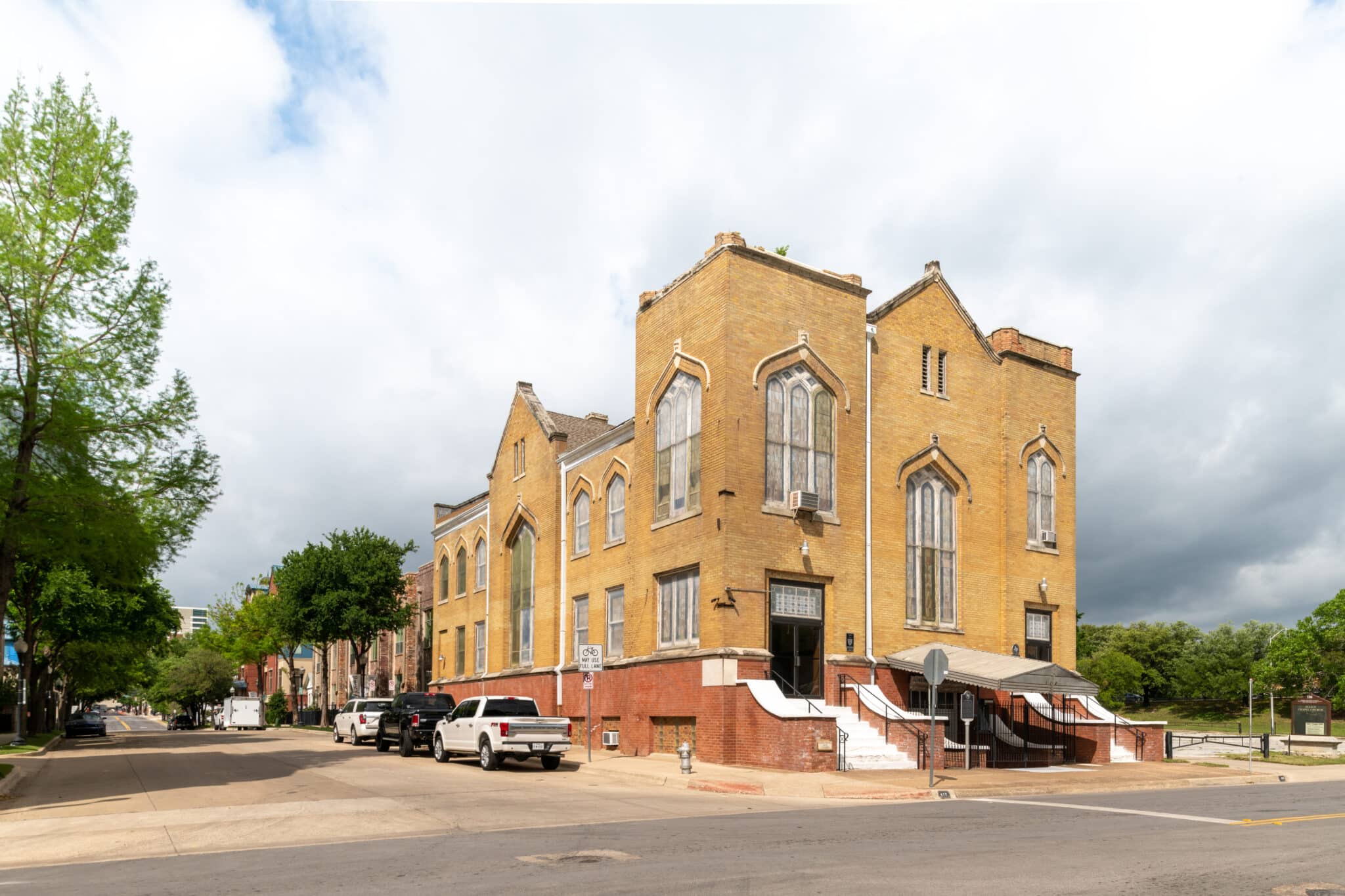
Historic Fort Worth, Inc.: Fort Worth’s 11 Most Endangered Places in 2023
By Tori Couch and Scott Nishimura
Historic Fort Worth, Inc. announced its 2023 Most Endangered Places List on Wednesday afternoon, featuring 11 properties, including Fort Worth Independent School District athletic properties and the Fort Worth Community Arts Center and Scott Theater.
The Most Endangered Places List, which Historic Fort Worth has published annually since 2004, highlights historic properties in Fort Worth that face threats ranging from financial to developmental pressure and is released during National Preservation Month.
Historic Fort Worth, in compiling its list from nominations, works to raise awareness of the properties and address issues such as deferred maintenance, lack of landmark designations and protection, loss of parking, and lack of awareness of economic incentives to rehabilitate historic buildings.
Buildings designated as Recorded Texas Historic Landmarks, Texas State Antiquities Landmarks, and on the National Register of Historic Places qualify for the Texas Historic Preservation Tax Credit Program. This provides 25 cents back on every dollar spent on approved restoration expenses.
Fort Worth is home to 8,500 historic buildings, second in the state of Texas behind San Antonio (11,000), HFW Executive Director Jerre Tracy said.
2023’s Most Endangered Places:
Allen Chapel, 116 Elm St.
Allen Chapel opened in 1914 and was designed by William Sydney Pittman. Allen Chapel is named after former slave and bishop Richard Allen and is the oldest African American church in Fort Worth and Texas. Pittman designed several churches and the Colored Carnegie Library, which is the only library for blacks in Houston.
Allen Chapel is owned by the church congregation and received the Texas Historic Landmark designation in 1983 and was listed in the National Register of Historic Places in 1984. The bell tower was removed after being struck by lightning in 2011 and has not yet been replaced.
Deferred maintenance due to a lack of resources has made Allen Chapel an endangered property, Historic Fort Worth said. As a state and national landmark, approved restoration projects at Allen Chapel should qualify for the Texas Historic Preservation Tax Credit Program.
Historic Buildings for Sale by Fort Worth Independent School District
Several Fort Worth ISD buildings made the list due to development pressure.
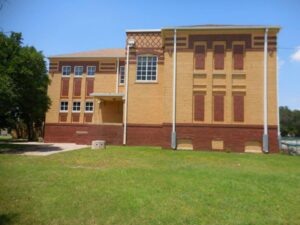
Boulevard Heights Transition Center, Fort Worth
Boulevard Heights Transition Center, 5100 Camp Bowie Blvd. Three buildings built in 1909, 1922, and 1954.
The oldest, closest to Camp Bowie, was designed by Sanguinet & Staats. The 1922 building was the first Arlingtion Heights High Schiool. Its first address was on 5100 Camp Bowie, as El Campo Street did not extend in front of the campus as it does today. It served as a high school until 1927, when it became a junior high school. In 1954, it became part of an elementary school. The 1954 building, designed by Wyatt Hedrick, connected the two other buildings. In recent years, the three buildings became a school for children with learning differences and was renamed Boulevard Heights Transition Center. This is Boulevard Heights’ first appearance on the Endangered Places list.
“These three buildings are endangered because the Fort Worth Independent School District listed them for sale without designation protection,” Historic Fort Worth said.
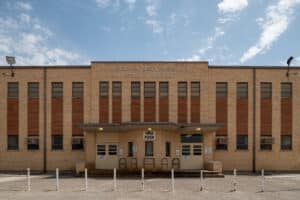
Farrington Field, Fort Worth
Farrington Field and Jack A. Billingsley Field House
Farrington Field is making its seventh appearance on the endangered places list. Built in 1939, the 20,000-seat facility cost $244,000 and was funded by Fort Worth Independent School District and the Works Progress Administration. It is named after longtime FWISD athletic director E.S. Farrington, and is located at 1501 University Drive.
Jack A. Billingsley Field House, originally known as Fort Worth Public Schools Gymnasium, is on the endangered list for the second time. Architect Preston M. Geren Sr. designed the gymnasium for basketball, volleyball and wrestling competitions. Rambo Construction built the concrete facility in 1953. The building was named after Billingsley – a coach, athletic director, principal and assistant superintendent in FWISD for 39 years – in the 1980s.
Both Farrington Field and the field house were put up for sale without historic designation protection in 2020. A consultant helped write a nomination to the National Parks Service in 2021 and both properties were listed as contributing to a National Register Historic District in February 2022. Even with the state tax credit, the facilities are endangered due to development pressure, Historic Fort Worth said..
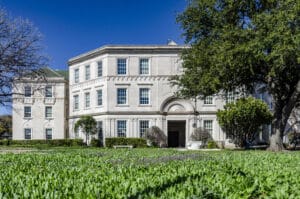
W.I. Cook Memorial Hospital
W.I. Cook Memorial Hospital, 1212 W. Lancaster Ave.
Set on a terraced hilltop, the hospital was designed by Wiley Clarkson and built in 1929 with endowed funds provided by Mrs. W.I.. (Matilda) Cook, who intended services to be provided without regard to ability to pay. The design draws from Romanesque and Reniassance sources. When Cook Children’s moved to the Near Southside, Health South bought the West Lancaster property and built an addition. Today, it’s owned by SBAB Realty in Dallas. “The building has been vacant for several years and the level of maintenance appears to be low,” HIstoric Fort Worth said.
An architecture firm hired in 1991 to conduct a survey of historic buildings in Downtown Fort Worth said the hospital building should be eligible for placement on the National Register of Historic Places. “That listing would qualify an improvement project in the historic hospital building for state restoration tax credits, which are 25% on the dollar,” Historic Fort Worth said. Potential future uses for the building include an art museum or collection, Historic Fort Worth said.
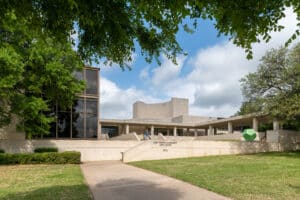
Fort Worth Community Arts Center
Fort Worth Community Arts Center and Scott Theatre, 1300 Gendy St.
Initially built in 1954, the FWCAC has made the endangered list twice. Herbert Bayer, an Austrian graphic designer, architect, and landscaper, designed the building. The William Edrington Scott Theater was added in 1966. Fort Worth’s Joseph R. Pelich and theater designer Donald Oenslager from New York designed the theater. O’Neill Ford and Associates of San Antonio added another section to the center in 1974.
The FWCAC was once a museum and an art school with administrative offices on the second floor. It then served as the home for the Modern Art Museum. Several art-affiliated groups now operate out of the city-owned building. Paid parking nearby has affected the business plans of the arts groups that rely on public support, Historic Fort Worth said.The parking fees “pay off” debt for newer buildings in the area, which puts the FWCAC and its tenants at risk, it said.
A city task force recently moved forward with recommending redevelopment plans for the Arts Center. The task force will finalize its recommendation May 24 and present them to the Fort Worth City Council June 6.
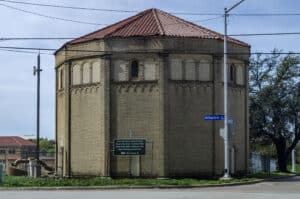
Holly Pump Station
Holly Water Pump Station, 920 Fournier St.
The Pump Station opened in 1892 to serve Fort Worth’s significant growth. The station was laden with new water pumping technology of the time. The city’s Holly Water Treatment Plant began full operations in 1918. The plant became the North Holly Water Treatment Plant in 1948, after a major expansion. The facility reached its current capacity in the late 1960s. “The vulnerability of the Pump Station’s location at an extended corner of Fournier Street and West 10th Street contributes to the endangerment of this rare 12-sided building,” Historic Fort Worth said.
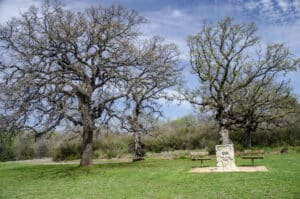
Peninsula Club Circle Lake Worth Civilian Conservation Corps. marker
Peninsula Club Circle, a Lake Worth Civilian Conservation Corps. Marker, 4044 Peninsula Club Circle
Not much remains of the Civilian Conservation Corps at Camp 1816 at Lake Worth, but remnants of a flagpole have been uncovered. The original site was built in 1937 and planned by the architectural landscape firm Hare and Hare of Kansas City, Missouri.
The members of the CCC constructed roads and built bridges, stone picnic tables, roadside fireplaces, public toilets and water fountains. Rocks cut from cliffs along the lake shore were used to build shelter houses and outlooks, some of which are still standing today. A monument in the Fort Worth Nature Center documents the CCC’s work while other federal program funding helped expand the fish hatchery and build the two WPA bridges on the old state road section of Meandering Road at Silver Creek and Live Oak Creek. The CCC started in 1933 and during its nine-year lifespan employed about 3 million people. The CCC resources are endangered because they are not landmarked. They could also become official parks of the City of Fort Worth.
“These resources are endangered because they are not landmarked and they should become official parks of the City of Fort Worth,” Historic Fort Worth said.
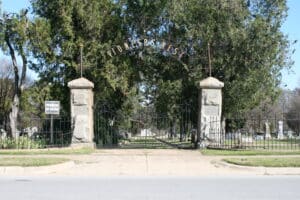
Pioneers Rest Cemetery
Pioneers Rest Cemetery, 620 Samuels Ave.
Established in 1850, Pioneers Rest is Fort Worth’s first and oldest cemetery. It includes two State of Texas historical markers — one for the cemetery that was dedicated in 1979 and the other for Gen. Edward Tarrant that was dedicated in 1988. Pioneers Rest was listed in the National Register in 2021, with a total 29 historic resources. Recent threats include apartment complexes with renters who use Pioneers Rest as a dog park, an apartment complex designed with virtually no space between the cemetery perimeter walls and apartment building wall, and a spark from equipment at the apartments that ignited a fire at the cemetery, Historic Fort Worth said. “The pioneers are restless at Fort Worth’s oldest cemetery,” Historic Fort Worth said.
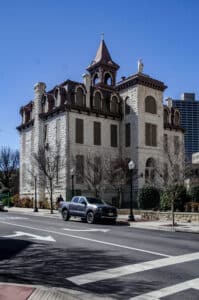
St. Ignatius Academy
St. Ignatius Academy, 1206 Throckmorton St.
The Sisters of St. Mary Namur founded St. Ignatius Academy in 1885. Fort Worth architect James K. Kane designed the building in the French Second Empire style. St. Ignatius, owned by the Catholic Diocese of Fort Worth at St. Patrick Cathedral, is the only Fort Worth building built in that style, which features a mansard roof, dormer windows, cupola tower and decorative chimneys.
The building received Texas Historic Landmark designation in 1962 and was listed in the National Register of Historic Places in 1985. The basement has been used for choir practice, but the main floors “appear mothballed,” Historic Fort Worth said. As a Texas and National landmark, St. Ignatius qualifies for the Texas Historic Preservation Tax Credit Program.
The Diocese is working on repairs to St. Ignatius after damage from a recent storm, Edward Smith, who spoke at the Historic Fort Worth announcement and is chief of staff to St. Patrick Cathedral, said. “The bones of the building are pretty phenomenal,” he said.
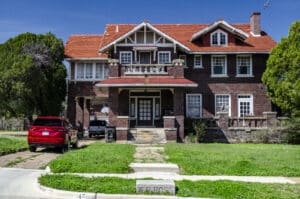
Waddy Russell home
Waddy Russell Ross Home, 1352 Park St.
This North Side home was built in 1917 by Waddy Russell Ross, a prominent horse and mule dealer. The home is designed in a rectangular plan flanked by gabled wings, porte-cochere, and conservatory bay. Owned for years by an individual, the home is “suffering from lack of maintenance and appears to need major work,” Historic Fort Worth said. HFW received two nominations for the Waddy Russell home. “I’ve just watched it deteriorate and deteriorate,” one of the nominators, Brenda Helmer, a board member of the North Fort Worth Historical Society, said after Wednesday’s ceremony. “It’s just heartbreaking.”
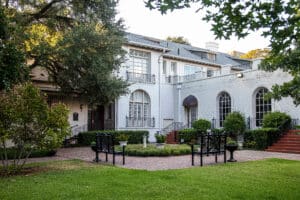
The Woman’s Club of Fort Worth
The Woman’s Club of Fort Worth, 1316 Pennsylvania Ave.
The Woman’s Club of Fort Worth, a 501(c)(3) charity, is a member-owned educational organization founded in 1923. The organization resides in four buildings covering 2.2 acres off Pennsylvania Ave. The buildings were built between 1903 and 1911 and The Woman’s Club acquired the buildings between 1923 and 1954. Landscape architects included Hare and Hare of Kansas City, Missouri and Carter and Burgess of Fort Worth.
The buildings are landmarked at the local, state and federal levels – Cultural Landmark of the City of Fort Worth, Texas Historic Landmark and National Register of Historic Places – and qualify for the state’s tax credit program. Members pay less than $50 per month in dues and have access to programming in the arts, literature, history, science, fine arts and other areas of personal and professional development. The club is currently running a membership drive to help cover the maintenance and operating costs for the buildings. The club has mounting maintenance needs it can’t meet under its current operating budget and investment earnings, putting it on the Endangered Places list.
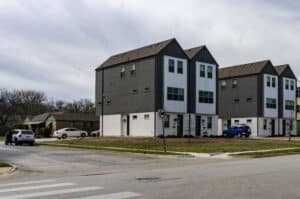
Westcliff
Westcliff and Other Neighborhoods 50 Years Old or Older
This nomination focuses on Westcliff and Westcliff West, but “many other neighborhoods within or near Loop 820 are also endangered,” Historic Fort Worth said. The post-World War II Westcliff was developed by J.E. Foster & Son. “Unfortunately, the historic residences are under attack due to lack of landmark protection,” Historic Fort Worth said. “Additionally, a loophole within the TCU Residential Overlay ordinance allows a residence zoned B-Two-Family to qualify for apartments” like stealth dorms that were constructed on lots on South Drive in recent years, Historic Fort Worth said.
